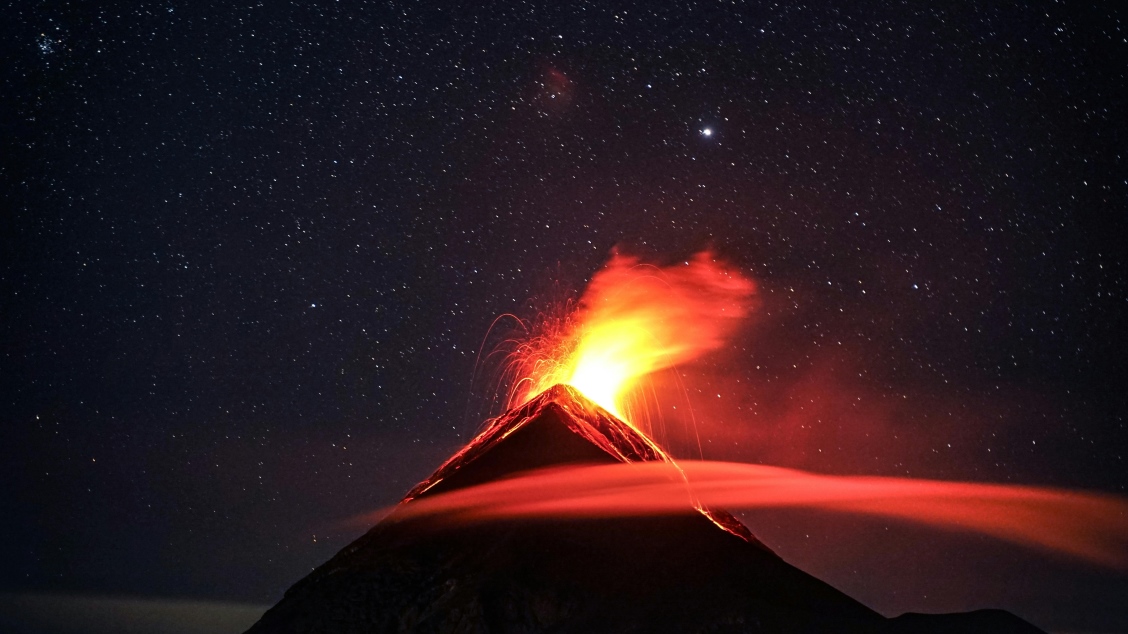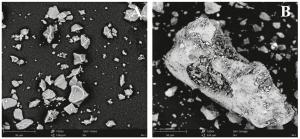
Living with Volcanoes and Adapting to Eruptions
In 2023, there were 77 eruptions from 73 volcanoes across 28 countries. Eruptions occurred in Chile, Iceland, Hawaii, Sicily, and elsewhere. Despite the number of eruptions not increasing, pictures and videos of volcanic eruptions circulated the Internet in 2023. For many, volcanoes remain mysterious and fascinating, representing potentially destructive forces that many societies live amongst.
Here, we go over the basics of volcanoes and eruptions, and discuss some of the risks they pose to human health. Then, we discuss how researchers are tackling the issue of adapting to life near volcanoes and even using ash to create sustainable materials.
What are volcanoes?
Basically, a volcano is an opening in Earth’s crust that allows molten rock, gases, and debris to escape to the surface.
The opening, or vent, tends to be a small bowl-shaped depression at the summit of a cone-like or shield-shaped mountain. Beneath and within a volcano, there are a series of cracks connecting the vent to stores of molten or partially molten rock, known as magma.
There are around 1350 potentially active volcanoes worldwide, not including those under oceans. Typically, there are 40‒50 continuing eruptions, and out of those around 20 will be actively erupting at a time.
But what are eruptions and why do they occur?
Why do volcanoes erupt?
Because of the high temperatures deep in Earth, rocks slowly melt and become a thick flowing substance called magma. Largely due to magma’s relative density to the rock around it, the magma rises and collects in what are called magma chambers, eventually pushing through vents and fissures out of Earth’s surface.
There are various types of eruptions.
Types of volcanic eruptions
Various factors influence the type of eruption, including the consistency of the magma. The simplest way to describe eruptions is whether they are effusive or explosive.
Effusive eruptions occur when magma is thin and runny, meaning gases can easily escape. This means the lava flows out slowly.
Explosive eruptions occur when magma is thick, meaning gases cannot escape easily. This leads to pressure building until the gases escape violently and explode, blasting pieces of rock ranging in size from tiny particles of ash to large boulders.
Eruptions can be one or feature elements of both types.
Kilauea eruption in Hawaii, USA
The Hawaiian Islands are each made up of one or more volcanoes, six of which are active. Of them, Kilauea is the youngest and most active. It erupted almost continuously from 1983 to 2018.
Kilauea is an example of an effusive eruption, as it generally slowly leaks out lava. This has caused lava lakes to form in the collapsed areas surrounding it.
In 2023, Kilauea erupted but did not pose any direct risks to inhabitants of the island.
Mount Saint Helens Eruption in Washington, USA
In May 1980, Mount Saint Helens erupted, which represented one of the most significant explosive volcanic eruptions in North America.
After an earthquake, an air blast caused a high-velocity cloud of superheated ash and stone to travel up to 15 miles away from the summit. This eruption of gas and ash caused mudflows, pyroclastic flows (mixture of rock fragments, gas, and ash), and floods that buried the surrounding valleys in deep layers of mud.
What risks do volcanic eruptions pose for humans?
An article in Toxics studied particles of ash from Popocatépetl, Mexico.
After a single eruption, volcanoes can generate tens of thousands of tonnes of nanosized ash. In strong eruptions, these nanoparticles can reach the stratosphere and spread around the globe, affecting the climate and different ecosystems for years. Because of their size, nanoparticles pose a direct risk to human beings, but their toxicity depends on various factors like shape, origin, and contents.
They can enter the body in various ways, including the mouth, nose, and skin. Inhalation is the main cause, meaning they can end up in the lungs and airways.
Analysing volcanic ash
The authors found that volcanic nanoparticles are very varied, as demonstrated in the image below.

The images show a general view of particles in an ash sample. They vary in shape, sphericity, size, and crystallinity. The second image shows one with a rough surface, sharp edges, and smaller particles around it.
By breaking up into smaller particles, they could further spread around the body to other vital organs. The authors cite a study that indicates they can potentially enter the bloodstream, accumulate in organs, and cross the blood‒brain barrier. This could lead to chronic inflammation, DNA damage, and disrupted cell processes.
The authors of the Toxics article found their samples contained potential toxic elements like arsenic and copper. Their findings demonstrate that volcanic ash poses a health risk to those living in areas near active volcanoes.
But how can communities adapt to living amongst eruptions?
Volcano tourism
An article in Land considers effective risk assessment and management on Tenerife and how these can be combined with promoting sustainable tourism and industry. Tenerife is the largest of the eight islands that make up the Canary Islands, Spain.
Despite the threat of eruptions, volcanic areas are attractive to locals and visitors. This is because volcanoes contribute to beautiful landscapes and fertile soils, which helps produce rich ecosystems. They create sources for primary minerals and resources, such as parts for mobile phones and computers. And tourists are attracted to them as they allow for seeing geological processes in action.
The study examines the Icod Valley, Tenerife, which is already prone to forest fires, floods, droughts, and coastal erosion, alongside volcanic eruptions. The area has over 50,000 inhabitants and has many visitors, but there is a lack of a comprehensive volcanic risk reduction plan as of 2024.
Volcano safety management
The authors suggest creating a long-term development plan based on hazard assessment and risk management. This includes revising mobility, energy, and water supply networks and ensuring their functionality even if severely impacted.
Moreover, since tourism is a primary source of income and employment, the authors suggest making visiting volcanoes as sustainable and valuable as possible. This includes rigorous planning based on scientific knowledge to establish the safest and most attractive and informative places to visit. This needs to be supported by accessible infrastructure, accommodation, and facilities to ensure safety and minimal environmental impact.
Here are some more of their suggestions:
- Display warnings in several languages;
- Display recommendations for visitors;
- Provide guides created by geologists with experience in disaster management.
The authors suggest that, by taking these steps, eruptions may even attract more tourism and generate more income because they’d be safely managed. A disaster, they explain, only occurs when it exceeds the management capabilities in the affected area.
Using volcanic ash to create sustainable materials
An article in Processes experiments with using volcanic ash from the island of La Palma, Spain, to create sustainable cement.
An eruption on Cumbre Vieja on 19 September 2021 deposited large quantities of volcanic ash, totalling between 8 and 9 million cubic meters, greatly impacting local citizens.
Damage to houses and infrastructure require construction materials which can have high CO₂ emissions when produced. However, the authors explain, volcanic ash is a natural pozzolan, which is a material that possesses no cement-like qualities, but when divided and combined with water, it forms cement-like materials.
Hence, the authors tested volcanic ash, material that would normally be treated as waste, in cement at varying levels. They found that over 25% substitutions of volcanic ash in cement are suitable, and that they can also be used for mortars and concretes.
Therefore, volcanic ash can be used to produce cement and other low-cost construction materials, supporting reconstruction after volcanic eruptions.
Learn more about volcanoes
In summary, volcanoes are vents in which molten rock can cause the ejection of lava, rocks, gas, and ash. This can cause a broad range of environmental impacts, and potentially risk life, even for those not in the surrounding area due to nanoparticles travelling far.
Therefore, researchers are looking for ways to adapt to living with volcanoes and even utilising their materials. We covered researchers that provided suggestions for how risk management can be used to support the tourism industry and increase safety and also use volcanic ash to more sustainably rebuild damaged houses and infrastructure after an eruption.
MDPI is committed to publishing vital research in an Open Access format, ensuring research is accessible to anyone, anywhere. If you are considering submitting research, look at our full list of journals.










